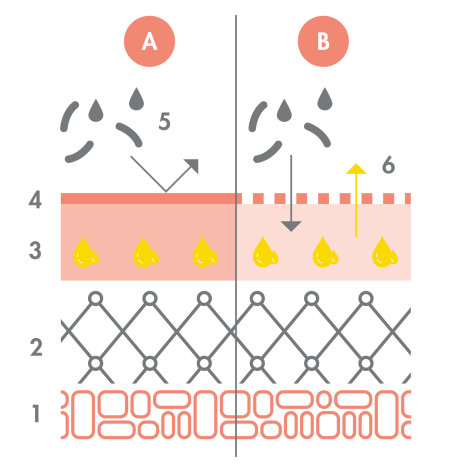Why nourish dry skin?
Unlike dehydrated skin, which lacks water, dry skin is skin that lacks lipids, in other words oils. The hydrolipidic film no longer functions properly and moisture evaporates more easily. It is therefore essential to nourish your skin to restore suppleness and radiance. We’re here to explain everything to you.

Dry skin: the tell-tale signs
When your skin is starving, you can feel it. Your skin feels tight and itchy, you don't feel good about yourself (so to speak).
But you can also see it as your skin tends to get drier in winter, those small, dry, rounded, slightly pink patches.
It also looks "wrinkled", red patches may appear during the day, the skin is thinner, your complexion looks dull...
All good reasons to give your skin what it needs.
Learn more about the signs of dry skin
I feel that my skin is feeling tighter and tighter so before I get to the point of scratching, I choose instead to use a cream to moisturise it.
Dry skin, a barrier to be restored
Dry skin is skin that lacks lipids. What does this mean in practical terms?
Our epidermis could be compared to a wall.
In this wall, our cells are the bricks and lipids act as a kind of intercellular cement. They ensure the cohesion of the cells. They help to maintain the skin’s moisture barrier, limit water loss and aid in protecting against external aggressors.
As you can see, if this cement is missing, the skin is more porous and less protected.
This is why you should not simply moisturise but nourish your skin when you experience dryness.

How to deeply nourish dry skin
Do you think that deep nourishment for your skin means applying rich skincare products? Yes, that's true, but there's more to it.
Cleansing is essential
Nourishment begins well before cleansing. Choose soap-free, superfatted products or lipid-replenishing washing gels which, as their name suggests, restore the right level of lipids to your skin, while cleansing it without damaging it.
Protect and nourish
Only then can you move on to the next step: nourishing and protecting. For this, turn to nourishing or lipid-replenishing products. The aim is to restore the skin’s moisture barrier and maintain a good level of hydration. A word of advice: apply your skincare products morning AND evening. The night is the ideal time for the skin to renew and regenerate itself.
FRIENDLY (AND EXPERT) ADVICE
If your skin is particularly dry, and therefore malnourished, a Cold Cream may be the solution.
Major solutions for tricky skin concerns. In the case of particularly dry skin, a nourishing product is necessary. Whether for your face, hands or legs, a cold cream will work intensively.
A quick tip: these creams are perfect for very dry areas that are often forgotten: heels, elbows, cuticles, etc. or to protect against the cold in winter.

Nourishing the skin from within
A balanced diet also contributes to healthy skin:
- Drink 1.5l of water every day. Our body (and a significant part of the epidermis) is in fact made up of 70% water
- To combat external aggressors, opt for antioxidants provided by fruit and vegetables
- Vitamin B5 helps restore the skins moisture barrier. You will find it in many mushrooms (such as shiitake), eggs or muesli
- Vitamin A also contributes to skin health. Dairy products, egg yolk and fish are excellent sources.
Our solutions for dry skin
Avène Thermal Spring Water skincare products designed to protect your skin
- Revitalising Nourishing Cream
Les Essentiels
Revitalising Nourishing CreamNourishes - Soothes - Protects
NEWSLETTER
We're always here for your skin!
All our tips on how to take care of your skin every day.

Which skin care routine should you adopt?
Identify what it really needs with the help of our experts and discover the most suitable skin care routine for you.



